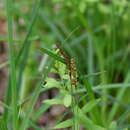Comprehensive Description
(
英語
)
由North American Flora提供
Carex polymorpha Muhl. Descr. Gram. 239. 1817
Carex Halseyana Dewey, Am. Jour. Sci. 11:313. pi. N, f. 43. 1826. (Type from Westfield, Massachusetts.) "Carex Halseyi Dewey" Eaton, Man. ed. 5. 156. 1829. (Change of form of name.) Loxotrema Halseyi Raf. Good Book 25. 1840. (Based on Carex Halseyana Dewey.)
"Carex striata Michx." Torr.; Boott, 111. Carex 21. 1858.
Carex panicea var. scariosa Olney, Caric. Bor.-Am. 3. 1871. (Based on C. polymorpha Muhl.)
Forming large beds when well-developed, strongly stoloniferous, the stolons very stout, woody, scaly, much branched, ascending or horizontal; culms 3-6 dm. high, stiff, erect, sharply triangular, little roughened on the angles, strongly exceeding leaves, strongly aphyllopodic, fibrillose and strongly purple-tinged at base; sterile shoots more or less elongate; leaves numerous on the sterile culms, about 3 with well-developed blades on the fertile, the blades flat, with slightly revolute margins, green, thickish, 2.5-5 mm. wide, not noticeably attenuate, roughened towards the apex, those on the fertile culms 1-1.5 dm. long and much shorter than the culms, those on the sterile culms from 1-3.5 dm. long; sheaths prolonged upward beyond base of blade and continuous with the long conspicuous ligule; staminate spike solitary (or with an additional sessile short one at its base), erect, narrowly linear-oblong, long-peduncled, 1.5-3 cm. long, 3 mm. wide, the peduncle smooth, the scales obovate, very obtuse, purplishbrown, with yellowish-white center and narrow hyaline margin, the lowest amplectant; pistillate spikes 1 or 2, erect, exsert-peduncled, remote, oblong, 1.5-3.5 cm. long, 7.5-10 mm. wide, often staminate at apex, the perigynia ascending or widely spreading at maturity, 12-25 to a spike, in several rows, closely arranged above, or often more closely below; bracts long-sheathing, the sheaths loose, green-striate ventrally nearly to mouth, the blades leafletlike, 1.5-7 cm. long, normally shorter than the culms; scales broadly ovate, acutish or obtusish, smooth or nearly so, purplish-brown with conspicuous, 3-nerved, green center, exceeded by and narrower than the perigynia; perigynia 4-5.5 mm. long, 2.5 mm. wide, the body ovoidorbicular, somewhat inflated, suborbicular-triangular in cross-section, 2-keeled and obsoletely nerved, glabrous, puncticulate, densely minutely granulose, submembranaceous, olive-green, round-tapering at base and abruptly contracted into a beak of about half its length (1.75 mm. long), cylindric, slender, purplish-tinged, excurved, the apex strongly oblique, hyaline, entire or nearly so; achenes broadly obovoid, 2.5 mm. long, 2 mm. wide, loosely enveloped, triangular with slightly concave sides and sharp angles, blackish, minutely papillate, sessile, abruptly slenderly apiculate, obscurely jointed with the somewhat upwardly enlarged style; stigmas three, slender, blackish.
Type locality: "Habitat in Pennsylvania."
Distribution: Dry open woodlands, acid soils at low elevations, southern Maine to Maryland; rare and local. (Specimens examined from Maine, New Hampshire, Massachusetts, Rhode Island, Connecticut, New York (Long Island), New Jersey, Pennsylvania, Maryland.) The North Carolina record is based on Carex Walteriana L. H. Bailey, once confused with this species.
- 書目引用
- Kenneth Kent Mackenzie. 1935. (POALES); CYPERACEAE; CARICEAE. North American flora. vol 18(5). New York Botanical Garden, New York, NY

